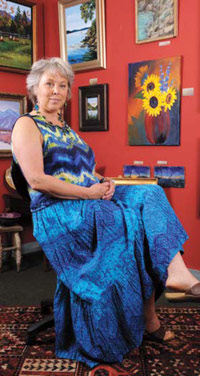
Alison Lambert Vernon '90 controls her knife with quick, deft motions, exhibiting the smoothness and deep concentration of a surgeon wielding a scalpel. Her hand travels swiftly, assuredly, back and forth from canvas to palette as she mixes, scrapes, and applies a rainbow of paint in strokes, jabs, curving motions, and small, controlled slashes. Soon, the picture begins to emerge, and it is a thing of beauty, exquisitely, surprisingly detailed considering it was created with a knife instead of a paintbrush. When finished, if it is not a commissioned piece, the picture may hang among others in Alison's Little Brook Gallery in New London, N. H., where browsers will be able to enjoy it until it is sold.
Alison is the fifth of six daughters born in a span of nine years. Her family lived on a dairy farm in Cortland, in upstate New York, until her parents became interested in the business of harness racing. That meant a lot of travel all over the eastern half of the United States to racing venues in places such as Maine, New York, Kentucky, and Ohio. “So, here we were,” Alison says, smiling at the recollection, “with six little girls, all switching schools as many as nine times in one year. However, this seemed normal to us—we were real vagabonds—and it was a lot of fun, especially when the harness tracks included a fairground, because then we could scrounge for stuff at the various booths.”
The family moved to Delaware in 1968, and eventually her father, whom Alison describes as “very entrepreneurial,” bought a tugboat and a couple of barges, got his tugboat license, and “went on to make himself a very rich man.” Alison enrolled at the University of Delaware and received her B.A. in sociology. She worked on the tugboat in the Chesapeake Bay to earn her tuition money. “I had crewed two years sea time by the time I was 21,” Alison recalls, “and I got my Able Seaman License. Interestingly, my mother was the first woman in the United States to have her Tugboat Operator License.”
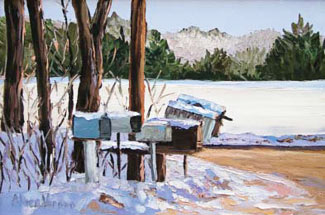
Alison met her husband, Mark, while at college, and they moved to New London, where he built them a house. They have three children, Jeremiah (27), and twin girls Deborah and Arrolyn (25). “It was when the girls turned two that I decided to go back to school for nursing,” Alison says. “Colby-Sawyer gave me the best financial package, so I enrolled there.” Alison graduated summa cum laude in three years and was the corecipient of the David H. Winton Award, which is presented to the student in the graduating class with the highest overall grade point average for their college career. “I think nursing school was the hardest thing I've ever done in my life—by far,” Alison says. “But I learned so much and Colby-Sawyer prepared me beautifully for my entry into the world of nursing.
“I worked for New London Hospital right after college and then I went to Dartmouth-Hitchcock Medical Center and worked in the Coronary Intensive Care Unit for three years. I was so well prepared by Colby-Sawyer that I was quickly included in the charge nurse rotation. After that I went into cardiology research for three years, but that was not a rewarding job for me. It was a lot of paperwork and not much fun. I missed the patient contact.
“I transferred to the Lake Sunapee Region Visiting Nurse Association (LSRVNA), and that was one of the best jobs I ever had—it's an excellent program and I learned a lot. I thought I would retire from there. From the very top to the bottom, it was the best of people, and they provide excellent care to this community. I did hospice work, which is caring for people who are no longer receiving active treatment for their disease and who have decided to let nature take its course. I did that for nine years. It was quite intense, because you're with people at a very personal time in their lives and in the lives of their family. I always considered it a privilege to be with them at that time, but it was also a very emotional time, and I didn't realize until I had stopped providing hospice care just how draining it was.”
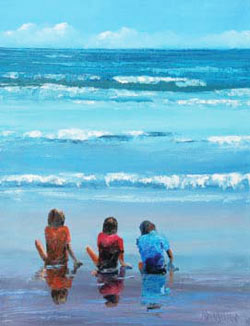
At the time Alison left the LSRVNA she was the clinical director, and she was in charge of case management for a huge geographic area. “It was so rewarding,” she says, “but it was also a job that required a lot of juggling because you wanted to bring out the best in all the people who worked for you, provide the best care possible, and yet stay within a very tight budget. I had come back to Colby-Sawyer to take three business courses, so between that and the nursing I was very well prepared for that position.”
But in the background, always pushing to move forward into the limelight, was Alison's true passion.
The First Bolt from the Blue
“For many years, I never realized I was an artist or that I had any interest in painting,” Alison says. “I'd pace the floor feeling these creative urges, and I'd try anything—knitting, sewing, macramé—and nothing really thrilled me. I couldn't feed the craving. It was really that intense and I would just drive myself crazy. Then, about 23 years ago, a friend, who had been left some oil paints by her grandmother, asked me if I wanted to try some painting. She gave me some oil paints and I had my canvas, and I dabbed my brush into the oil paint and touched the canvas. It was just as if I had been struck by lightning, a bolt from the blue. It was an epiphany, a true eureka moment. It was, oh my god, I've finally found it! And I've painted almost every single day since that moment. It was that profound.”
The Second Bolt from the Blue
“I painted with brushes for about ten years,” Alison explains, “and then one day I was doing a demonstration at the local elementary school. I needed some paint on the canvas—it was a painting of apples that I still have—and for some reason I reached for a palette knife and smeared the paint on. Again, it was POW! It was just the same thing as before, and I could almost hear a voice say, 'You're supposed to be a palette knife painter, didn't you know that?' The smoothness, and the texture, and the way it just slid on. I can just remember making those apples, and realizing that, yes, I was a palette knife painter.
“Since then, palette knife painting has been my passion. The knives provide a three-dimensional quality to a painting which, combined with color and light, helps to create a lively result. The under-painting is applied in a thin sheen with the details of a piece applied with heavier texture. I generally use 10 to 15 different knives on a canvas, each knife providing a unique texture and effect. A painting must be finished the day it is started because the palette knife must be able to slide on the canvas rather than getting hung-up on partially dried paint. This technique requires using greater quantities of paint, but the end result is fresh and exciting.”
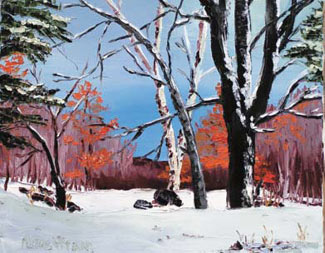
The Third Bolt from the Blue
It was while Alison was working as a hospice nurse that she realized she needed to be painting for a living, that it was time for her to follow a new calling. “I'm a very ambitious person,” she says, “and I realized I couldn't be happy just painting. I felt I had to go one step further and sell those paintings. I've got to market myself, I thought. I've got to set up a website. I've got to set up shows. During this time she had been passing by an empty shop near the Colonial Pharmacy in New London on trips to pick up medication for hospice patients. Just as it had happened twice before, the third bolt from the blue hit her head on. “Oh, my god, this empty shop—it's a gallery! It's my art gallery!” In October 2006 Little Brook Art Gallery opened its doors.
Alison admits she felt guilty—like she was betraying people—when she left the nursing profession. It took her some time, she says, to learn that art provides comfort, maybe not as tangible as that provided by nursing, but comfort nonetheless. “I love people and I love to make them happy,” she says. “My art is sort of like nursing, and I believe you can make people happy by practicing either profession. The way a nurse provides comfort measures to patients, I believe art can provide comfort in a similar way.”
Alison's subject matter is eclectic. She enjoys painting pet portraits, children, animals (wild and domestic), fantasy scenes, natural scenes such as lakes, fields, oceans and mountains, and, especially, she likes to create paintings for children. She has a series of works for children on her website, and she has put together a traveling exhibit of magical paintings for kids with thought provoking titles such as “Butterfly Repairman.” The exhibit debuted at the Opera House in Claremont, N.H., and it is scheduled to visit a number of libraries and children's hospitals throughout New England.
“Right now I have two shows coming up,” Alison says. “One is called 'All in a Row.' It's paintings of things you might see lined up, like colored bottles on a windowsill, birds on a wire, or sailboats on an ocean horizon. The other one is 'Magnificent Views of the Sunapee-Kearsarge Area.' These particular paintings are going to be on humongous canvases, unframed with painted edges.”
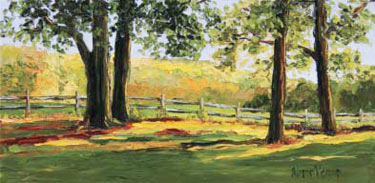
Alison is always looking for ways to use her artistic and business skills. Other projects she has in the works include a book on palette knife painting, which is a how-to book because, as she explains, “there are no other books like that out there.” She also generates business using today's mix of media. She has a website, a blog, sends out print and e-mail newsletters, and she has a dozen videos of herself on YouTube doing “speed paintings,” which allow the viewer to watch her complete a piece from start to finish at a fast-forward pace.
Alison's biggest dream is to be the next Bob Ross, the now deceased PBS-TV host of “The Joy of Painting” who parlayed his talent and his calm, patient, sleep-inducing demeanor into a booming industry for art products. With this dream in mind, Alison has produced a Bob Ross style video of herself painting with palette knives, “Although,” she says, “I'm probably more of the Rachael Ray type.”
With all of this going for her, it's probable that out there somewhere there's at least one more bolt from the blue ready to deliver another wonderful epiphany to Alison Vernon.
To view more of Alison's artwork, visit her website: www.alisonvernon.com.
-David R. Morcom


